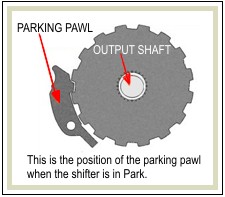What is a parking pawl?

A transmission parking pawl is a metal pin or lever that engages the transmission’s output shaft when the transmission shifter lever is placed in the “Park” or “P” position. When the transmission pawl is engaged it restricts the output shaft (and drive wheels) from turning in either direction.parking pawl
Contrary to common thinking, the primary purpose of the transmission’s “Park” position (and parking pawl) is to keep the engine’s power from reaching the drive wheels when the engine is running, not to keep the vehicle from rolling when parked – this is the job of the parking brake (or e-brake). In fact, relying solely on the transmission’s “Park” position and the parking pawl to keep the vehicle from moving when parked places undue stress on the parking pawl, which can lead to premature failure of the pawl.
Signs that your parking pawl is worn out or broken
If your vehicle rolls forward or backward an inch or two after placing the shifter in the Park position, the parking pawl is worn out and weak. If your vehicle rolls freely when the shifter lever is in the Park position the parking pawl is broken.
Parking on an incline
When parking on an incline, undue stress is placed on the parking pawl unless the e-brake is set before the shifter lever is moved to Park. If the shifter lever is placed in Park before setting the e-brake, the parking pawl is holding the weight of the vehicle, not the parking brake. Overtime, when the parking pawl is used in this way, it becomes weak and can break.
If the parking pawl fails while the vehicle is parked and unattended, the vehicle is free to roll as gravity dictates. This is why you should never rely solely on the transmission’s Park position to secure a parked vehicle – always set the e-brake.
IMPORTANT TIP:
Replacing a worn or broken parking pawl is expensive. To prevent premature parking pawl failure always set the parking brake before you place the transmission shifter lever in the Park “P” position. Doing so insures the weight of the vehicle is being held by the brake rather than the parking pawl. Following this tip will help keep your automatic transmission in top shape saving you both time and money.
Source:Â http://myautomatictransmission.com/the-parkiing-pawl.htm
